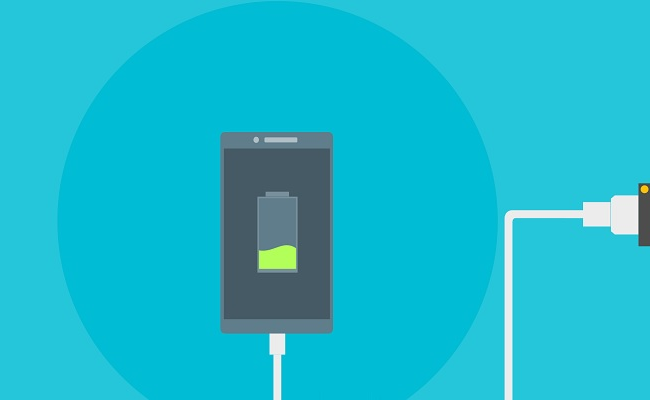
How Does Fast Charging Work? [Video]
Video uploaded by Techquickie on August 15, 2017
Everything About the Standards of Fast Charging
Ten years ago the first iPhones, Android smartphones and various Windows Mobile communicators appeared on the market. All of them had batteries with the capacity of 1200-1500 mAh and charging at ~ 1 A and 5 V. These batteries could be fully charged in 1.5-2 hours. Back then most devices could work at least until the evening or even managed to operate for more than one day. No one seemed to complain about long charging times.
Time passed, capacities of batteries started to grow, the time of autonomous work decreased, but the chargers remained the same. It eventually led people to spend hours near their chargers to make sure their smartphones would “live” until the evening. Manufacturers of course started to work on this problem. They could not increase the capacity of batteries, so they invented the standards of quick charging.
USB Battery Charging Revision 1.2
The USB consortium adopted this standard in 2011. Any manufacturer who equipped this device with a USB port could use it free of charge. While the standard USB 3.0 gave out no more than 900 mA at 5 V, the current rose up to 1.5 A, and charging time was significantly reduced.
In fact, this standard was not widely used: only top motherboards and laptops had such powerful USB ports. It was usually marked in red or a lightning bolt.

Unfortunately, manufacturers continued to pack their smartphones with 1 A and 5 V chargers, so people had to buy charging cables with Battery Charging 1.2 separately. This technology made it possible to charge phones significantly quicker without harming them.
Qualcomm Quick Charge 1.0-2.0
Qualcomm Quick Charge 1.0-2.0 is probably the most famous quick charging method. It was created in 2013. QC 1.0 could only support the Snapdragon 600 chipset. The voltage remained standard for USB (5 volts), but the current was raised up to 2 A — about one third more than that of BC 1.2. The first version of this standard was not very popular, so there is no sense in talking about it for a long time.
QC 2.0 became the first truly popular standard of fast charging. It worked with devices on many versions of Snapdragon. The main difference from the previous standards was that the current became limited to 2 A and stopped growing, but the voltage could rise up to 12 V. The reason for this was trivial: the majority of USB-microUSB cables of that time supported a current no more than 2.4 A, otherwise, they started to overheat. It was dangerous (as we know, heat losses are proportional to the current strength and the square of resistance). Therefore, Qualcomm went another way and tritely began to raise the voltage. Finally, the maximum power became 18 W (12 V and 1.67 A) against 10 W (5 V and 2 A) in the first QC version.
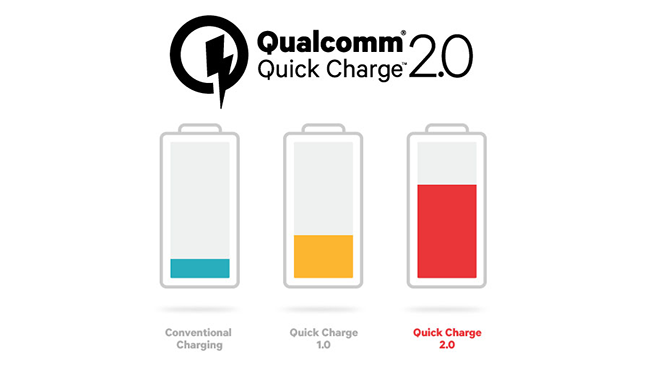
Manufacturers started to use special voltage controllers and equip charges and smartphones with them. The controllers «communicated» with each other using D + / D- contacts in the USB port, and the smartphone selected the required voltage and amperage. Some chargers did not support QC (did not respond to the special voltage on D + / D- contacts), so the process of charging went with the current of 1 A at the voltage of 5 V.
Unfortunately, the first problems appeared with the release of QC 2.0: due to the power of 18 W, the batteries began to overheat. It negatively affected their lifespan. Of course, the standard had a safe temperature range, but manufacturers often turned a blind eye, so that marketers could please users with attractive slogans like «80% in one hour».
After the release of Snapdragon 810, things got worse. Given the fact that Android often increases its background activity while being connected to the charger (for example, program updates), the CPU then warms up. Its users had a massive problem of batteries degrading rapidly and motherboards breaking from overheating. This problem was very popular among the owners of LG G4, Nexus 5x and Flex. In response to numerous complaints, the company recommended to use fast charging only when it is really needed, not during the night. Users did not like this response and filed a class-action lawsuit against LG.
Qualcomm itself does not name the normal charging time, it just says that now the process goes 75% faster than with QC 1.0. Independent tests show that a smartphone with a ~ 3000 mAh battery can be charged with QC 2.0 by 50% in about 40 minutes.
USB Power Delivery
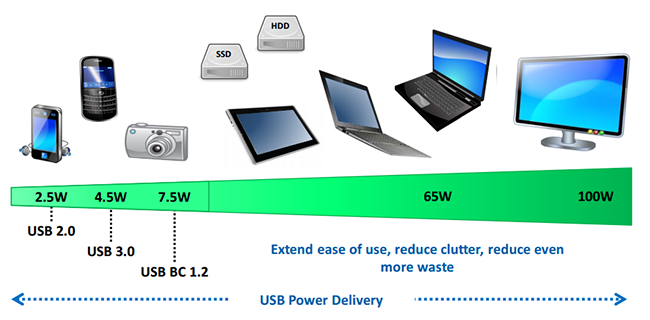
USB-C devices began to massively appear in 2015. Since this protocol was able to contain many others, manufacturers began to choose USB 2.0 or 3.0 — accordingly, there were not any problems with the QC 2.0 support.
Later it became more interesting. The USB consortium created the Type-C 1.2 standard which supported the current of 3 A at the voltage of 5 V. For example, Lumia 950 and 950XL smartphones had this fast charge. Such cables had a special control chip inside. It could work only at 5 V, but QC 2.0, as we remember, could raise the voltage right up to 12 V. Since they did not check for microcircuits in the cable of the QC standard, this could have been bad for the cable and smartphone.
Of course, Google did not stand aside from this problem. This company officially recommended smartphone manufacturers not to use USB-C with QC 2.0. However, many manufacturers (for example, OnePlus) assured their users that there would not be any problems with their cables. Finally, when the smartphone burned out because of the third-party cable, it was the user’s problem.
Then everything became even more amusing. In order to distinguish the cables (the ones which were able to pass 3 A, 1.5 A and 1 A) the USB consortium decided to equip them with 10, 22 and 56 Ohm resistors. Chinese manufacturers, as usual, decided to put only 10 Ohm resistors into their cheap cables. This decision led to the fact that all devices with the USB-C 1.2 support started to «understand» that they could take 3 A and began to request it from the charger. You’d never guess what happened! At its best the charger gave a current which was possible (it was unlikely to be 3 A). At its worst, it simply burned and possibly damaging the connected smartphone.
At the end of 2015, the USB consortium released the specifications of Power Delivery 3.0 standard. It is possible that in the future everybody will use it. It allows you to set the voltages from 5 to 20 V and the current from 1.8 to 5 A, so that the maximum power can reach as much as 100 watts — this is enough to charge a laptop. Many modern solutions like Xiaomi Notebook or Apple MacBook now use it. The type of connector can be USB-C, microUSB or even USB-A, and the transfer can to go in both directions. This means that you may charge your phone from another one. There is a backward compatibility with USB-C 1.2, so, as an example, you can charge your Lumia 950 using the charger with the PD support. All possible charge combinations are shown below:
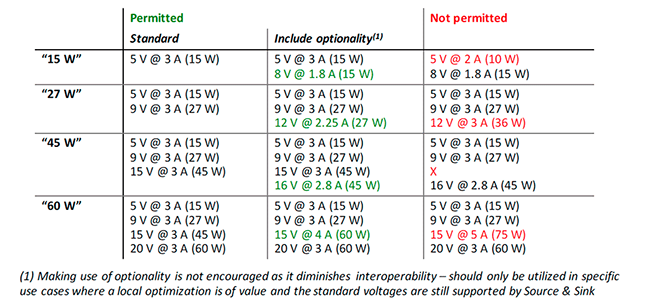
Qualcomm Quick Charge 3.0-4.0
Of course, the company clearly realized that the problems with overheating must be addressed. With the release of Snapdragon 820/821 in 2016, the company introduced the new QC 3.0 technology. Qualcomm stopped chasing power (it remained within 18 W), but created a flexible voltage setting. If in the version 2.0, 5, 9 or 12 V were rigidly set, here the voltage could be changed within the range from 3.6 to 20 V. In addition, manufacturers themselves got the opportunity to limit the maximum voltage, for example, at the level of 12 V. Plus, new Snapdragon (supporting 821, 820, 620, 618, 617, 430) were colder than the previous version. Finally, the problem with overheating was solved.
Unfortunately, another problem with USB-C still remained. It was very risky to use third-party cables for fast charging through this port. As for the charging speed, the company promised that almost all smartphones with QC 3.0 will be charged by 70% in half an hour:
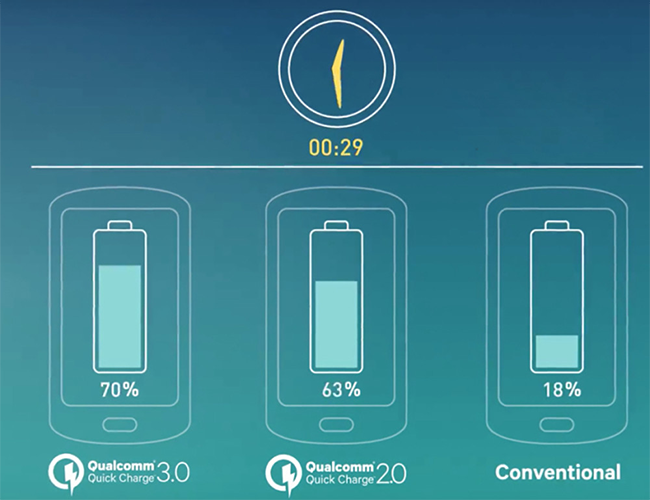
QC 4.0 standard was introduced at the end of 2016. It solved many problems. First of all, it could be used with any of the USB-C cables. The charging speed of course depends on the cables, but it is faster than with a standard 1 A or 5 V. A full compatibility with the Power Delivery is this new charger’s second important feature. It will first ask the connected device if it supports PD. If not, it switches to QC mode.
The QC 4.0 standard has the same specifications as 3.0: up to 18 W at the current up to 2 A and the voltage up to 12 V, and up to 27 W through the PD standard. The supported chipsets are Snapdragon 630, 636, 835. According to Qualcomm, the technology allows to recharge the device with a 2750 mAh in only 5 minutes. It also takes only 15 minutes to charge the battery from 0 to 50%.
QC 4+ technology was introduced in 2017. It does not differ from 4.0 very much. For example, Dual Charge technology allows you to split the current into two streams. It reduces the temperature by 3 degrees and increases the charging speed to 15%. The supported chipsets are Snapdragon 660, 670, 710, 845.
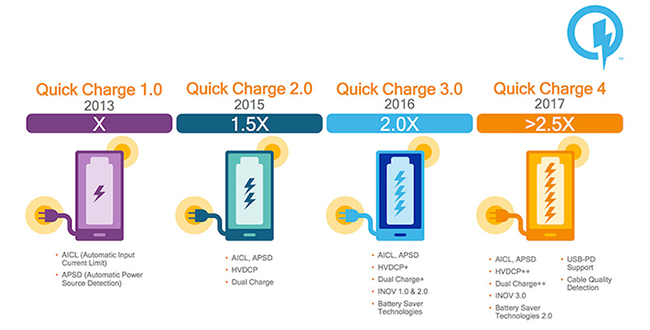
Backward compatibility
All QC versions, starting from 2.0, are backward compatible. For example, imagine that your phone’s QC version is newer than your charger’s version. In this case, the protocol is supported by the charger. If you connect your smartphone with an older version of QC to the charger with a newer one, the effect will be completely similar to using the charger with the same version of QC that the device supports.
The compatibility of Power Delivery with Quick Charge 2.0 and 3.0
Officially, there is no compatibility, but in practice there are different variations. There are smartphones like Nexus 5x or 6p which support PD and QC — in both cases they will be charged quickly. Or… your charger and your gadget will not «understand» each other, so you will get a very slow charge with 1 A and 5 V, or there will be no charging at all. The worst scenario is that your device without PD support may be supplied with 3 A and 5 B (USB-C 1.2 standard) due to the «wrong» cable with a 10 Ohm resistor. This situation is unpredictable because QC standard does not work with such currents, so your smartphone may simply refuse to be charged. Your phone might even burn. Therefore, if your device supports QC 2.0 or 3.0, be very careful while selecting the cable and charger.
Apple’s fast charge
Traditionally all iPhones are equipped with chargers for 1 A and 5 V. Of course, it does not mean that they can not be charged faster. Starting with the iPhone 6, users began to notice one interesting thing: if you use the charger from iPad at 12 W, the smartphone starts to charge faster. Yes, it does not take the maximum current, but 1.5 A is also good. Moreover, it turned out that Plus-versions are charged with larger currents than the usual ones.
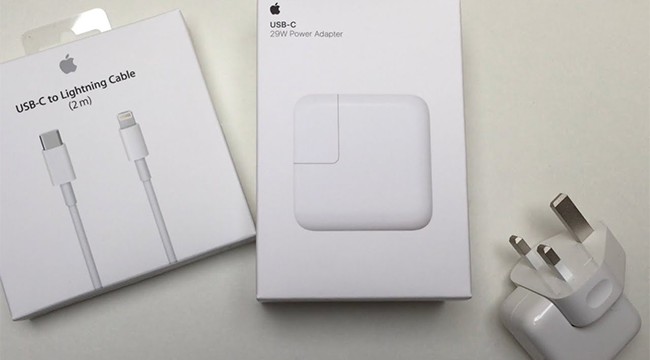
Anyway, the process of charging was rather slow. While Apple’s competitors offered to charge the battery by 50-60% for half an hour, here it could hardly charge by 20-30%. In 2017 Apple finally decided to use the technology of fast charging according to the standard of Power Delivery (PD). To use it you need an original Lightning cable (USB-C), a power adapter with PD support (Apple recommends using its own intended for 29-87 W, but does not prohibit any other). After completing all requirements, you will get 50% of charge in only half an hour. This is not the best result, but it is much faster than charging via the iPad’s power adapter, and many times quicker than charging from the original charger.
An obvious question arises: what other adapters can I use? The answer is simple: any adapters which are compatible with PD. If you use the adapters without its support (for example, with Quick Charge 3), there are different variants. In the worst case, you will get «standard» 1 A and 5 V, at best, it will be something similar to charging via the iPad adapter, and the current will vary from 1 to 2 A. You should also use the official Lightning cable — USB-C. It is also possible to use any Apple-certified cable. A cable with no certification can «kill» your smartphone.
Huawei Fast Charge Protocol (FCP), Samsung Advanced Fast Charging and Motorola Turbo Power
These technologies are not just mentioned together often, in fact they are clones of QC 2.0. The creation of FCP is understandable, since Huawei has its own Kirin processors, so the technology needed to change. But Samsung and Motorola mainly use Qualcomm processors, so their fast charging technology is just a rebranding.
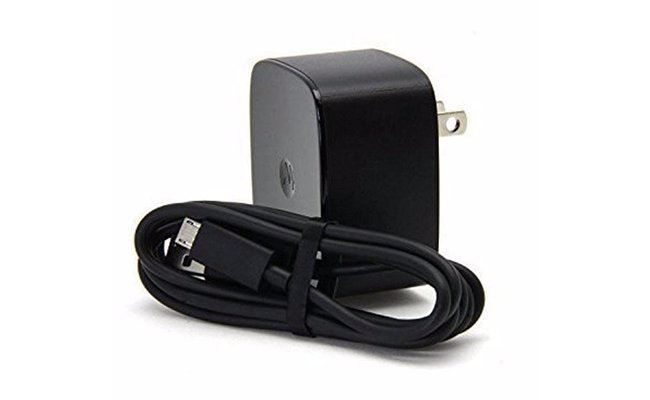
These standards are compatible with QC 2.0 (besides FCP — but there adapters could also have support for the protocol from Qualcomm), so they are compatible with each other. Motorola’s charger gives out up to 25 W — the maximum result.Charging speed varies depending on the manufacturer. For example, Moto X Force (3760 mAh) is charged by 80% in 45 minutes.
Mediatek Pump Express+
Mediatek Pump Express+ is also the clone of QC. Unlike other technologies without any continuation (like Samsung Advanced Fast Charging), PE + has three different versions:

As you can see, the first two are the complete repetitions of the QC standards. Moreover, LeEco has already produced chargers compatible with both QC and PE.
The differences start from PE + 3.0. When Qualcomm in QC 4.0 continues to use small currents (1-2 A) with large voltages (up to 20 V), Mediatek decides to go another way. Its charger’s voltage ranges from 3 to 6 V, the current may be more than 5 A. Considering the fact that most cables are designed for 3 A, PE + 3.0 needs a special cable.
Almost all Mediatek Helio chipsets are supported (funny, but the company does not disclose the full list). Meizu Pro 6 on Helio X25 with a 2560 mAh battery can be fully charged with PE in just an hour.
Officially, there is no backward compatibility. At the same time, Mediatek says that PE + 2.0 and 3.0 standards can work in parallel and be installed in devices together according to the requirements of the manufacturer.
OPPO VOOC and OnePlus DASH Charge
In fact, OPPO and Vivo belong to the same BBK Electronics concern, so the difference between these technologies is only in their names. VOOC appeared in Oppo Find 7 smartphone in 2014. Later it was used in various devices of F, R and N series. As for OnePlus, the first smartphone with the DASH-VOOC support was 1 + 3. Later this technology was used in every new OnePlus smartphone.
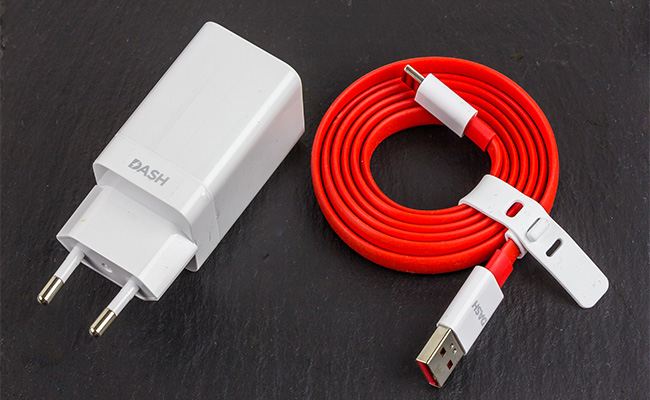
What is its main feature? Like Mediatek, OnePlus decided to increase the current, not voltage, and eventually got the same 20 W as QC 3.0, but using 4 A and 5 V. As far as overheating, 1+ controls everything. Two batteries are simultaneously charged with smaller currents, so the possibility of overheating is very small. Moreover, the part of the charging circuit was moved to the power adapter in order to further reduce the heat.
What was the result? If you want to try DASH, then use only an original charger with an original wire. Does Snapdragon support QC? Not in this case. If you use third-party adapters, you will get no more than 1.5 A and 5 V. Instead of going to standardization, the company creates its own non-compatible standard.
What about the charging speed? It is at the same level as the new QC, about 60% in 35 minutes. At the same time, it makes you «connect» with DASH. If you are not afraid of such an inconvenience, go ahead and use this technology.
Huawei SuperCharge
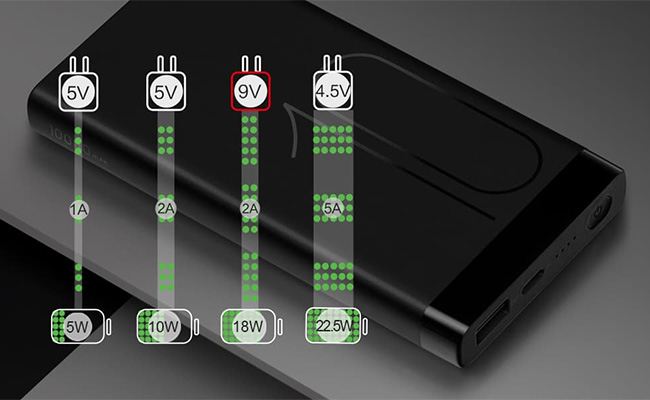
Earlier most adapters with Huawei FCP were compatible with QC 2.0. Now the company uses a completely new format of fast charging. This format is incompatible with any other. As for the characteristics, the standard is quite similar to DASH (5 A at 4.5 V), so not only do you need a special power adapter, but also a proprietary cable which is able to withstand such current.
Anyway, 22,5 W makes this charger the best in speed and smoothes out all its small imperfections. With its help, the battery of Huawei Honor 10 smartphone with a capacity of 3400 mAh was fully charged in only 73 minutes — a very impressive result.
Meizu Super mCharge
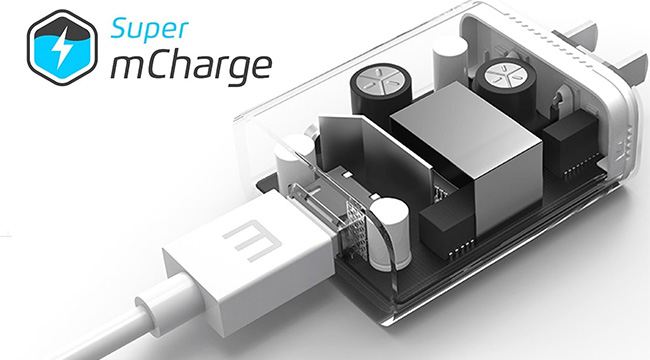
At the MWC 2017 exhibition, Meizu surprised everybody with the presentation of its new very fast charger. Using it, you can charge a 3000 mAh battery of your phone by 60% in 10 minutes, and completely in only 20 minutes!
This result is achieved because of the unprecedented power of 55 W — it is nearly 2.5 times more than that of DASH and SuperCharge. Such power occurs due to the current strength of 5 A and the voltage of 11 V. Of course, you need a special cable and charger to use this technology. The cable itself is designed for 160 W (8 A and 20 V) and is able to withstand 10 thousand connections. The maximum temperature during the process of quick charging will not exceed 39 degrees, so the risk of overheating will be absolutely excluded.
Conclusion
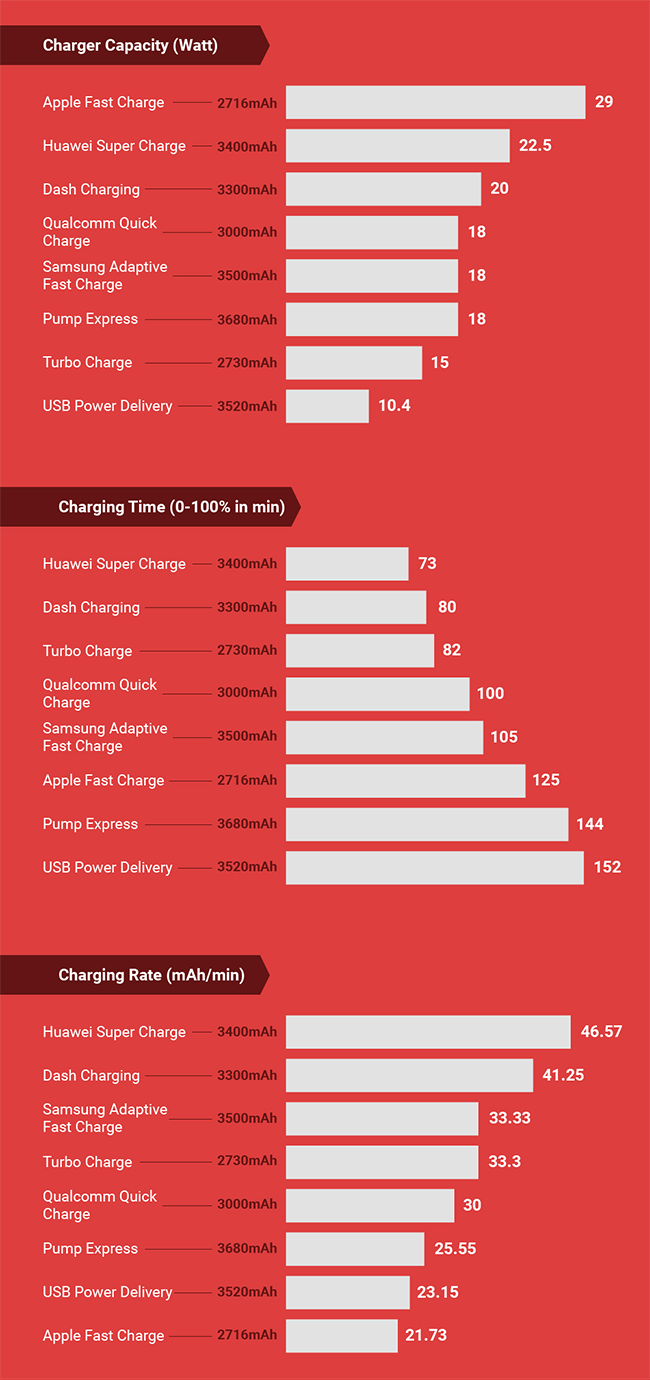
A comparison of Smartphone Fast Charging standards. Photo credit: Hometop
As you can see, almost every (more or less) large smartphones’ manufacturer of our time decided to release its own fast charging technology. At the same time, many existing chargers are incompatible with competing solutions. It is difficult to call it a good decision. At least, there are more and more large manufacturers, such as Apple and Qualcomm, who try to use the only one standard called Power Delivery, and it pleases us very much. We hope that other companies will follow their example and standardize their technologies in the nearest future.
Useful links
- Fast Charging: Does it Damage the Battery? – iGotOffer
- Understanding the USB-C – All You Need to Know – iGotOffer
- Understanding the USB-C Cable: What Type to Choose? – iGotOffer
- TOP 7 Myths About Battery Charge on Your Smartphone – iGotOffer
- Infographic: A comparison of Smartphone Fast Charging standards – Hometop
- Thinking to sell your phone? iGotOffer is the best place to sell smartphones and other devices online.

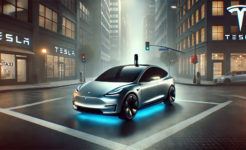
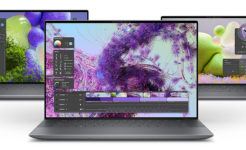

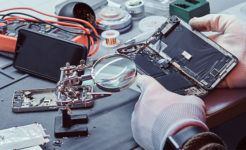
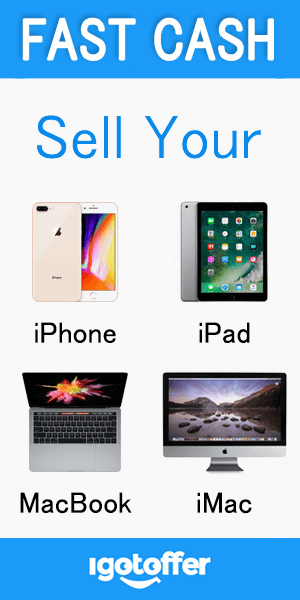
Facebook
Twitter
RSS